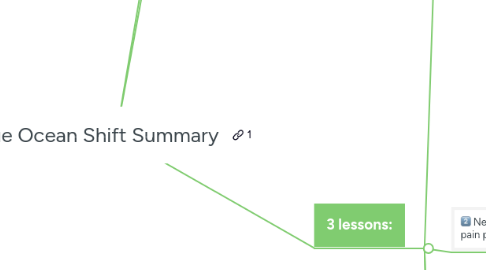
1. 1-Sentence-Summary:
1.1. Blue Ocean Shift guides you through the steps to beating out your competition by creating new markets that aren’t overcrowded.
2. Favorite quote from the author:
2.1. "Blue ocean strategists do not seek to beat the competition. Instead they aim to make the competition irrelevant." - W. Chan Kim & Renee Mauborgne
3. 3 lessons:
3.1. Learn the ways that new markets are created to get into your own blue ocean.
3.1.1. Blue ocean is a niche that isn't overcrowded.
3.1.2. With a blue ocean market strategy you can significantly improve the success of your business.
3.1.2.1. But to get there, you must first understand how to create new markets.
3.1.2.2. It might seem simple to think that a new idea is enough, but getting more specific is better.
3.1.3. There are three types of strategies to create new markets:
3.1.3.1. Disruptive innovation
3.1.3.1.1. Disruptive innovation happens when new technological advancements beat out older ones and “disrupt” the industry.
3.1.3.1.2. An example:
3.1.3.2. Non-disruptive creation
3.1.3.2.1. This means neither replacing or destroying a market.
3.1.3.2.2. Instead, this type of blue ocean comes when a company forges into addressing a previously unsolved problem.
3.1.3.2.3. An example:
3.1.3.3. Redefining an existing problem
3.1.3.3.1. A company named Groupe SEB took this strategy with making french fries.
3.1.3.3.2. They saw the existing problem in a new light and created a brand new market for it.
3.1.3.4. In other words, you need to replace an existing product with a breakthrough, solve a brand new problem, or look at an existing customer struggle differently.
3.2. New opportunities are hiding within the pain points that customers experience.
3.2.1. To solve problems, examine what makes it difficult for people to accomplish a task to uncover their pain points.
3.2.1.1. A good blue ocean strategy takes a look at the hidden troubles customers might have.
3.2.2. Using what the authors call a buyer utility map, you can see different areas that customers might struggle.
3.2.3. Imagine a table made of six rows and columns.
3.2.3.1. Across the columns, you have the buyer experience stages:
3.2.3.1.1. Purchase
3.2.3.1.2. Delivery
3.2.3.1.3. Use
3.2.3.1.4. Supplements
3.2.3.1.5. Maintenance
3.2.3.1.6. Disposal
3.2.3.2. Then, down the rows, you’ve got what are called utility levers:
3.2.3.2.1. Customer productivity
3.2.3.2.2. Simplicity
3.2.3.2.3. Convenience
3.2.3.2.4. Risk reduction
3.2.3.2.5. Fun and image
3.2.3.2.6. Environmental friendliness
3.2.4. Once you’ve built out your table, walk yourself through each stage a customer experiences when using your product.
3.2.4.1. In the case of a company that sells wine, for example, they would start with looking at how a person chooses a bottle.
3.2.4.2. They would examine each stage of the experience, looking for pain points that aren’t currently being solved.
3.2.5. To make this most effective, as yourself questions like “what makes it hard for the customer to be productive?” and “what takes away the fun of using it?”
3.2.5.1. With each answer, also examine why customers would feel the way they do about the answer.
3.2.6. When you uncover the hidden struggles people have, you can change your offering to help people in ways that nobody else is.
3.3. The assumptions that businesses make when selling a product are another great place to discover blue oceans.
3.3.1. Go through the four actions framework by asking yourself a few more questions.
3.3.1.1. What parts of your industry are unnecessary and can be eliminated?
3.3.1.2. Are there options we give that can be reduced below the current standard?
3.3.1.3. Which factors need to have the standard improved?
3.3.1.4. Can we create new offers that don’t currently exist?
3.3.2. Let’s take a look at the example of a hotel chain named citizenM to understand these better.
3.3.2.1. Thinking of what they could eliminate, the company removed concierge and front desk services.
3.3.2.1.1. Without these “necessities,” visitors didn’t need to wait in line to check in.
3.3.2.2. Next, we have the reduction of standards.
3.3.2.2.1. At citizenM, they reduced room sizes significantly.
3.3.2.2.2. Customers don’t spend much time in their rooms other than in bed, so why keep that extra space?
3.3.2.3. Pairing it with the next step, however, was also important to not dip too far below maintaining the comfort level of their guests.
3.3.2.4. To help hotel-stayers have the best experience, citizenM drastically improved the quality of their beds and sheets.
3.3.2.4.1. Also keeping absolute silence, they worked to make the sleeping experience one of the best their customers had ever had.
3.3.2.5. And last, citizenM looked for new opportunities they could create to improve their offering.
3.3.2.5.1. Without the concierge services, the company started having “ambassadors” whose job it was to answer questions and solve problems.
3.4. Who would I recommend the Blue Ocean Shift summary to?
3.4.1. The 54-year-old CEO who wants to set their company apart from the competition, the 28-year-old business owner that is looking to create a new product, and anyone who is entrepreneurially minded.
